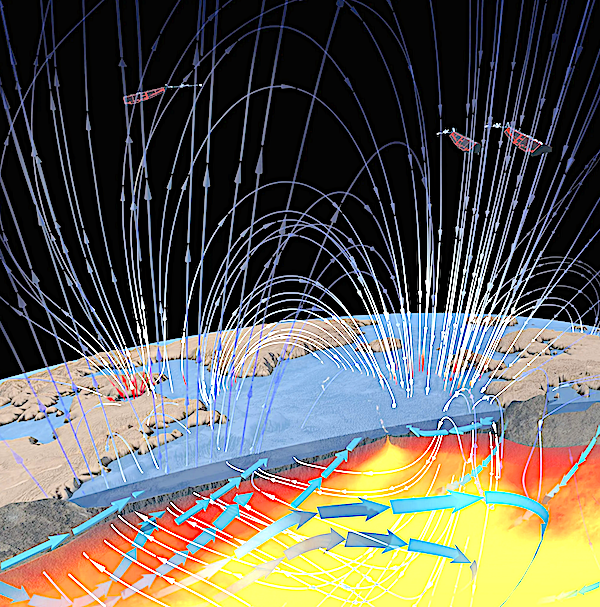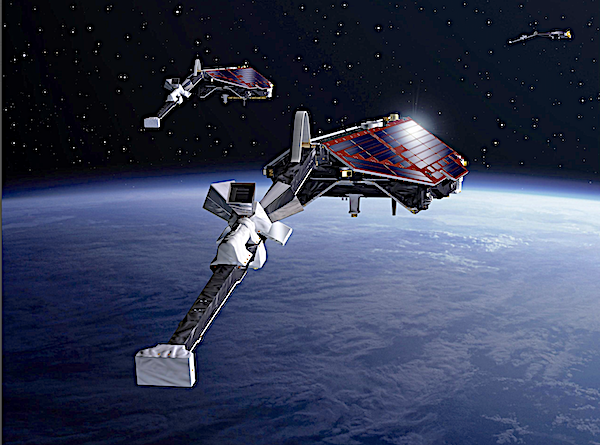
ESA’s Swarm mission, utilizing the faint magnetic signals generated by Earth’s ocean tides, offers groundbreaking insights into undersea magma distribution and potential changes in global ocean temperatures and salinity.
These discoveries, revealed by a long-standing satellite constellation originally launched in 2013, have provided unparalleled data that could transform our understanding of the Earth’s underwater dynamics and its geomagnetic field influences.
Magnetic Oceanography
A recent study using data from ESA’s Swarm mission reveals that faint magnetic signals generated by Earth’s tides could provide valuable insights into the distribution of magma beneath the ocean floor. These signals may also help scientists better understand long-term changes in global ocean temperatures and salinity.
The Swarm mission consists of three satellites dedicated to studying Earth’s geomagnetic field. This protective field, which extends from deep within the planet out into space, is primarily generated by the movement of liquid iron in Earth’s outer core. Additional sources of magnetism come from magnetized rocks within the Earth’s crust.
While oceans are not typically considered sources of magnetism, the salty seawater acts as a moderate electrical conductor. As ocean tides move through Earth’s magnetic field, they generate weak electric currents. These currents, in turn, produce faint magnetic signals — subtle but detectable from space by Swarm’s highly sensitive instruments.

Advancements in Magnetic Signal Detection
With its satellites flying at an altitude between 462 km and 511 km, Swarm measures Earth’s magnetic field more accurately than ever before. It can detect faint tidal signatures and distinguish them from other stronger magnetic field sources from Earth’s interior.
“This study shows that Swarm can provide data on properties of the entire water column of our oceans,” says Anja Strømme, ESA’s Swarm Mission Manager.
Swarm’s data can also provide insights into the distribution of magma, which could in the future support a better understanding of events such as the Hunga-Tonga volcanic eruption of 2022.
The study of these signatures made the front cover of the world’s oldest scientific journal, Philosophical Transactions of the Royal Society A, and was conducted by a team from the University of Cologne and the Technical University of Denmark.
Extended Mission Benefits and Challenges
The mission, launched in 2013, was only meant to fly for four years but is now in its 12th year. Anja adds: “This is one of the benefits of flying missions for longer than originally planned. So, by flying as long as the scientific output is of excellent quality and resources allow, you can tackle scientific questions that weren’t originally envisaged.”
Swarm is, however, slowly nearing the natural end of its lifespan as drag gradually brings the satellites physically closer to Earth. This has enabled the mission’s instruments — the satellites carry state-of-the-art sensors including magnetometers that measure the strength, magnitude and direction of the magnetic field — to capture faint signals that would be more difficult to detect from the higher orbits at the start of the mission.
Impact of Solar Activity on Magnetic Detection
Swarm’s ability to detect faint ocean signals was also helped by the Sun’s less active period around 2017. “These are among the smallest signals detected by the Swarm mission so far,” says lead author Alexander Grayver, of the University of Cologne.
“The data are particularly good because they were gathered during a period of solar minimum, when there was less noise due to space weather.”
The ‘minimum’ period of the Sun’s 11-year solar cycle is when the Sun’s surface is least active. During this ‘quiet’ period, it emits less solar matter – including electromagnetic radiation and charged particles – so ‘space weather’ phenomena such as the Northern Lights are less frequent. And with less electromagnetic radiation from the Sun, the geomagnetic signals from Earth are more easily detectable by Swarm’s magnetometers and other instruments.
The hope is that, when the next solar minimum comes around after 2030, Swarm might still be flying – albeit at a lower altitude – and will be able to continue detecting the faint signals that can help us understand more about the temperatures and salinity deep within our oceans.
By European Space Agency (ESA)
